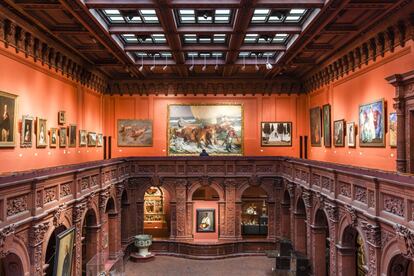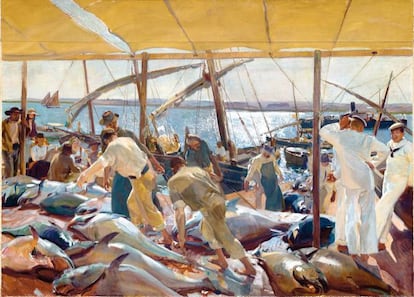Guillaume Kientz, director of the Hispanic Society of America: "In just over half of the United States, Spanish will be spoken."
“If you look deep into their hearts, you can read the hearts of the Spanish people,” wrote American art magnate, philanthropist, and Hispanist Archer M. Huntington during his first trip to Spain in 1894. A few years after that trip, Huntington, a passionate lover of Spanish art and everything related to the Iberian Peninsula, founded the Hispanic Society of America in the Washington Heights neighborhood of northern Manhattan. With more than half a million objects, including works by El Greco, Velázquez, Goya, and other great masters, the museum just celebrated its 120th anniversary, becoming the flagship of Hispanic American culture in the United States.
Guillaume Kientz (Strasbourg, 45), its director, appointed in 2020, has been responsible for reopening the institution after nearly seven long years of renovations and is the mastermind behind a new Hispanic, more dynamic and closer to Spain. “There is no Calatrava Bridge connecting New York with Spain, but we can build cultural bridges,” says Kientz in perfect Spanish, which he learned on the streets of Madrid and which, he explains, he has perfected since living in Harlem. “In the coming years, we are going to give greater visibility to the Hispanic in Spain,” he announced during a conversation with EL PAÍS in one of the living rooms of James Costos and his husband, Michael Smith, in Madrid. Costos, a former U.S. ambassador to Spain and member of the Hispanic Board of Trustees, met with the New York institution's U.S. and international trustees at his Madrid home this week, marking the culmination of a trip through northern Spain in which they followed in the footsteps left by Huntington 131 years ago.
The meeting also served to celebrate the announcement of an imminent long-term collaboration agreement with the Generalitat Valenciana (Generalitat Valenciana) that will allow the return to Spain of part of the collection of works by Joaquín Sorolla , which until now has been dormant in the storage of the Hispanic Museum in Washington Heights. This collaboration will culminate in a space in Valencia, Sorolla's hometown, that will house important paintings by the artist on loan from the American museum. "We want to give these paintings the best light, and what better light than that of Valencia?" says Kientz.

Question: How many Sorolla works does the Hispanic Society have?
Answer: We have a collection of 243 works.
Q. How many of these paintings will be donated to the Generalitat Valenciana?
A. We don't have a final list yet. We're working on it with the help of Blanca Pons-Sorolla, Sorolla's great-granddaughter and one of the greatest experts on his work.
Q. Could the 14 Vision of Spain panels be part of this transfer?
A. No, it won't be leaving the Hispanic Society. Vision of Spain is a monument. Monuments don't move; they're visited.
Q. Is there any possibility of Hispanic opening a branch in Valencia?
A. No, it's not going to be a museum that we'll manage directly. Our space is in New York, and we already have a lot of work there.
Q. Will Hispanic lease the works to the Generalitat? Will it be a lease?
A. It will be like a wedding. We're working on an agreement based on a concept that Americans really like: win-win . That is, it will be positive for everyone.
Q. Is there a date for that “wedding” yet?
A. Not yet. We're working on the contract. But we've agreed on the terms and the important details. It just needs to be translated into legal language.
Q. But will it be formalized this year?
A: Yes, we want to sign as soon as possible. We have a team of American and Spanish lawyers, and the Valencian Government has its own legal team. Everyone is working on it.
Q. Could Trump's new tariff policies affect the agreement?
A. I hope not. We're discovering every day how this new world is developing.
Q. Is Sorolla still a great unknown in the United States?
A. When it was first exhibited at the International Exposition organized by Huntington in 1909, it was an incredible success. The exhibition lasted a month and more than 160,000 visitors passed through the halls of the Hispanic Society. The museum had to stay open until 11 p.m. because of the long lines. Then, like all figurative art at that time, Sorolla lost much of his prestige in America, but he's regaining it. Now the Metropolitan is organizing a major exhibition of Sargent , who is the American Sorolla, and it's having great success. We just finished a Sorolla exhibition at the Norton Museum in Palm Beach, which was very well received. People like Sorolla; he's a painter who unites and brings people together . That's very important right now. We need consensus to build.
Q. The Hispanic is far from the circuit of major New York museums. Is that a drawback?
A. From my perspective, we have a very good location, in a very interesting cultural neighborhood. We're close to the Cloisters of the Metropolitan Museum, Hamilton House, the house where George Washington lived, Columbia University, and City College. And just a little further up is the Botanical Garden. We're creating a network to make people aware of everything they can do in northern Manhattan.

Q. We Spaniards are very familiar with Hispanic. Are New Yorkers equally familiar with it?
A. A little less because we were closed for almost seven years, and New York is a city that moves very fast. Before, people would set a goal of going to the Hispanic once every five years to always see the same thing: Velázquez, El Greco, Goya, Sorolla... Now, after the reopening in 2023, we have a very dynamic exhibition policy. Every three or four months, we organize experiences. For the next three years, we'll have fashion shows in the fall. Next fall, it will be about fashion in the Golden Age, in 2026, it will be about the mantilla, and in 2027, it will be about the Manila shawl. And every spring, we invite an artist to engage in a dialogue with our works.
Q. You were curator of Spanish art at the Louvre, one of the largest museums in the world. Is it easier to manage a small museum like the Hispanic?
A. This is a small institution, but at the same time very large. We have a collection of almost 800,000 objects. It's a lot, it's immense. Because we're small, we have to work harder, but we're also more agile.
Q. Hispanic culture has long been treated as marginal in the United States . Is that changing?
A. I don't know if it's a marginal thing. In the United States, they eat a lot of Spanish food, they drink a lot of Spanish wine, the dollar sign is Spanish... The problem is that Americans don't realize the influence Spain has on their culture. People forget that a little bit, and I don't really understand why.
Q. You, like more than 60 million people in the United States, speak Spanish fluently. Is this the time for Spanish?
A. In just over half of the US population, Spanish will be spoken . Our programs are already available in both English and Spanish to help families maintain the language as part of their linguistic heritage. In the US, many still view Spanish as a secondary language, but I'm beginning to see a paradigm shift. Many new leaders are Spanish speakers and are changing the rules of the game. Look at Bad Bunny , Rosalía, or the actress Eva Longoria , who is learning a lost language.
Q. But the average American doesn't even know where Spain is.
A. I don't agree. The people I know love Spain. But maybe I'm wrong.
P. Trump said in his last campaign that Latinos want to be called “Hispanics.”
A. Words have political uses. Of course, "Hispanic" is closer to Spain, because Hispania was the ancient name for the Peninsula, and "Latin" is a term that came much later. But in the end, it's not the words that matter. It's the people that count.
Q. Is there a figure like Huntington in the United States right now, a patron of Spanish culture of that stature?
A. There are very important collectors of Spanish and Latin American art, although I don't know if anyone is so passionately devoted to Spain. But we can find him.
Q. For a few years now, there's been some revisionism about how Huntington acquired its collection . Are you studying it?
A. That's very interesting. As a curator of Spanish painting at the Louvre, I often encountered a feeling of discomfort on the part of the Spanish regarding the Napoleonic invasion and the Peninsular War. They would tell me, "The French plundered us." And it was very fair, because that happened. But I've never felt anything similar about Huntington. On the contrary, people welcome us here with great affection and see the Hispanic Society as a declaration of love for Spain. And that's for a reason: Huntington always had immense respect for Spain, for the Spanish people, and for Spanish heritage, and he never wanted to remove things from Spain. In one of his diaries, he said that paintings are like birds, that they shouldn't be disturbed or taken from their trees. And he said that those who have lost their trees had to be saved, that they had to be provided with a new tree. The Hispanic Society is a tree that shelters lost paintings of Spanish art.
EL PAÍS




